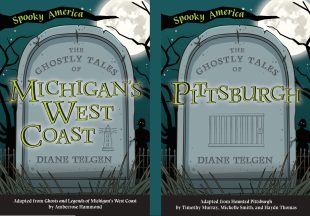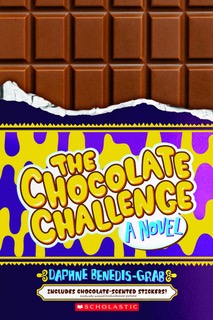Hello Mixed-Up Filers!
Today, I’m pleased to welcome Diane Telgen, Jay Whistler, Jenn Bailey, and Jules Heller to Mixed-Up Files. These authors share their experience of writing work-for-hire spooky stories for the middle grade audience.
Welcome to Mixed-Up Files, Diane, Jay, Jenn, and Jules!





Suma: Could you tell us what your Haunted series book/books are about?
Diane: The “Spooky America” series explores local legends about haunted places and famous ghosts. It takes volumes originally published for Arcadia’s adult “Haunted America” series and reworks them for a middle-grade audience. In The Ghostly Tales of West Michigan and The Ghostly Tales of Pittsburgh, I focused on one particular location, so the stories could involve houses, ships, or places of business. In The Ghostly Tales of Michigan’s Haunted Lighthouses, all the stories involve lighthouses, but the ghosts themselves vary between keepers, their families, and sailors.
Jay: I was fortunate enough to work on THE GHOSTLY TALES OF SAN ANTONIO shortly after I moved to the area in late 2020. While the title suggests ghost stories, the book is really about the history of San Antonio, beginning with the first Spanish settlers in the 1500s, moving to the fights over control of the territory, the civil war, and ending with the middle of the twentieth century. I knew Texas had been its own country before it became a state, and I think we all know the legend of the Alamo. But there is so much more to Texas and to San Antonio. I have a new appreciation for my adopted hometown as a result of this book.
Jenn: I wrote the Haunted Newport book, which tells spooky tales and ghost stories from in and around Newport, Rhode Island.
Jules: My book is THE GHOSTLY TALES OF THE FINGER LAKES, a collection of eighteen spooky stories from Western Central New York State. From an early draft of the introduction: Whatever your style, I promise there’s a story here for you. You like music? Listen close and you’ll hear the piano music of Miss Eunice Frame, resident ghost of the Sampson Theatre. You’re more interested in math? Help me count the strange deaths (and funerals) at the Erie Mansion.You prefer art? Read on for colorful stories of ghostly stains on basement walls that can’t be covered up. Science is more your thing? Try to explain what causes apparitions to be seen in an old doctor’s office. You enjoy a good mystery? Maybe you’ll be the one to figure out what scared the restaurant owners of the Dove Building so much they left town without bothering to pack their bags. No matter the subject, the tales you’re about to read will thrill and amaze you. Some are funny, some are sad, and some may or may not be one hundred percent true . . . who’s to say what’s a local legend, and what’s an honest haunting? You might have to decide for yourself. But I guarantee that in these pages you’ll find many surprises: secret societies organize kidnappings, ghosts lock people in bathrooms, heads go missing, skulls are found, and there might even be a sea monster at the end. You’ll have to read on to find out.

Suma: What was the one thing you paid attention to, while writing a haunted book for the middle-grade audience?
Diane: Of course I wanted to choose stories that were appropriate for kids–I stayed away from really lurid legends, or those that didn’t have a lot of detail. And I also had to make my language and style more appealing for a young audience. But most important, I had to provide the historical context for kids to understand the stories. If they understand the importance of lighthouses on the Great Lakes in the nineteenth century, or how colonial settlers would have seen Pittsburgh as the western frontier, they’ll more easily connect with why these historical figures became ghosts. As I like to say, “ghosts are just history trying to get your attention.”
Jay: The source material on some of the chapters challenged me to make it age-appropriate for middle-grade readers. Writing about the tragedy of the Alamo requires a deft hand to make the horrors of war less brutal. In another chapter, I needed to find a more delicate way to describe the red-light district in San Antonio, especially when referring to nocturnal activities. I think many kids will understand the euphemisms, or at least guess at their meaning, but there’s no need to be as frank as one might be with adults. Nor do kids need to know the gruesome details of some of the murders that gave rise to some of the legends.
In addition, I tried to respect that kids of this age may not be ready for truly scary stuff. There will always be the kid, like me, who loves watching old scary movies, reading classic horror, or telling ghost stories during sleepovers. But plenty of kids are just beginning to test the boundaries of what they can handle. I wanted to respect the readers enough to give them a bit of a shiver while reading while still allowing them to go to sleep with no worries about things that go bump in the night.
Jenn: I wanted to make sure to create the right atmosphere – that involved including bits of history, perhaps giving some backstory to explain why this event might have happened at this time, and why there might be a ghost story attached to the area. Just saying a hotel or beach is haunted isn’t enough. The middle grade audience is savvy and curious, and they want to know Why this happened. They want to know what, how, and when. You have to put some context – or dare I say meat – on those old, withered, spooky bones.
Jules: There’s a distinction between “beguiling” and “offputting” that can be a wobbly tightrope to tread. The things that kids find “too scary” are often not what adults assume.* The Arcadia editors had a specific list of scary topics that were no-gos for their audience (assault, etc.) but I tried to keep as much of the fun, interesting, just-plain-weird kind of scary as possible, because I remember being that odd reader who devoured bizarre assassination attempts and torrid conspiracies. Ghost stories shouldn’t lead to actual nightmares, they should provide conversation starters that make people avoid you (or seek you out specially) at parties!
*I remember a brilliant essay about how parents tried to tone down Red Riding Hood by having the woodcutter chase the wolf away at the end, rather than killing him. They thought less gore meant more kid-friendly; the kids said “no, that means the wolf is STILL OUT THERE.”


Suma: How did you go about making place a character in your stories?
Diane: I opened each book with a short historical introduction, to introduce readers to what made each place unique. So for West Michigan, the forests, beaches, and Lake Michigan all became recurring characters. For Pittsburgh, its journey from frontier fort to Steel City, USA became an important theme. And for Michigan’s Lighthouses, the storms of the Great Lakes became a furious antagonist!
Jay: Each chapter in my book focused on a particular place, so I made sure to include details about buildings, what they looked like, when they were built, what purpose they served and how that changed over the years. I shared landscape details and included tidbits to make it come alive. For example, in one story, I talked about why the owner of the property built a stage-coach stop. Then I explained how long the trip from point A to point B would take with a horse and carriage, how often they would need to stop, and what it would feel like being jostled about in the carriage with only a wooden seat under your backside. I want kids to not only see these places in their minds but also feel what it would be like to experience life as the characters in the story would. How would it be to see an elevator operator in a blue suit and gloves float out of a defunct elevator and beckon you inside?
Jenn: By talking about the people that inhabited it. What kind of people would live there? Why would they live there? Connect a certain type of person to the place – Newport was founded in 1639 on a promise of religious freedom and equality. These people were escaping the intolerance of Massachusetts. So you connect a certain type of person to the place, and then connect the reader to that type of person and you’ve got a reader who can envision characteristics and qualities about the location. Newport is a beautiful seaside city but there are a lot of those. You have to sprinkle the history of an area into these stories so they become individualized and relatable.
Jules: This is the big secret about these stories (certainly in my book, likely in many others): we don’t actually have any “true” or “real” characters to start from EXCEPT for the places. So much of this history is handed down from unreliable or unreportable sources, that in order to turn it into something readable and honest you have to take hefty liberties with the facts. Details about specific people can sometimes be brought in from old photographs, but personalities, motivations, even whole sections of The Plot have to be spun out of thin air. Thus, the grounding realness of the story comes from the physical place itself, which you as the storyteller can point to and say “You can visit the place where this happened! You can see the stains on the floor, hear the wind whistling through the broken window shutters!” Building on a foundation of the tangible remnants of the story, turning the locations themselves into historians and storytellers, lends credence to the rest of your cast and gives them some weight of their own.

Suma: What did you enjoy most about the process of working on this project?
Diane: I love history, so digging into the local details behind a particular ghost provided so much fun!
Jay: My favorite aspect of this project, aside from learning more about San Antonio, was challenging myself to take material kids typically find deadly boring—history—combine it with material usually reserved for adults—the “horror” genre—and make it appealing to middle-grade readers. I grew up watching the black-and-white horror movies of the 1930s and 1940s. I read my first Poe story when I was eight. I began reading Stephen King when I was in seventh grade (way before the Goosebumps books became popular). Working on this book brought back those memories and inspired me to create a similar experience for my readers. Perhaps one day, there will be an author who becomes the next Clive Barker because they read the entire Spooky America series and discovered not only a love of history and horror but of storytelling, too.
Jenn: Learning more about my hometown. Rhode Island is the smallest state in the U.S. and often overlooked, but it played a huge role – sometimes positive, sometimes negative – in the founding of this country. It was rather crucial during WWII as well. It was delightful to be reminded of some of the attributes of Newport that make it such a special place. I have my own personal reasons to love it, I was married in Newport, but it was a joy see this place through fresh eyes.
Jules: Quite honestly, it was just nice to have a project, any project, to work on at that point in the pandemic. I had some scheduling hiccups with the editors and ended up with a tight timeline for the manuscript, so I had to dive in head-first and stay under for a couple weeks straight, getting words on paper. It was energizing, a little hectic, but at the time just what I needed to rejuvenate my creative process. It also gave me an excuse to reorganize my physical work area, which is always a bonus!

Suma: What is your advice for writers doing work-for-hire projects like this one?
Diane: As with any project, knowing what your editor expects is important. But it’s crucial when writing within a series, because your individual book needs to fit within the volumes that have gone before you. So always make sure you have a style guide to follow, and communicate clearly about the schedule. Work-for-hire projects, especially in series, often have little wiggle room!
Jay: Work for hire can be a great way to make connections in the literary community. You learn to work on deadline and under stringent expectations. But it can also take away time from the personal projects you want to work on. So it’s crucial to know exactly what you sign up for.
With that in mind, make sure you know specific deadlines for every phase of the project. It’s okay to insist the entity you are working with details everything. The same goes for the expected end product. What exactly do they want you to deliver? This includes content and format. What is the revision process? Do you get a final review to make sure they haven’t substantially changed anything that would make it factually inaccurate? Who holds the copyright? For how long? If they hold the copyright, will it ever revert to you? What is the pay? Do you get free or discounted author copies? Are there royalties? If not, do you have a chance to hand-sell copies on your own to boost your bottom line? If so, what help do they provide you with marketing? Most importantly, get it all in writing. And don’t let someone tell you a contract isn’t necessary. It is.
Jenn: I’ll be blunt. You aren’t going to make a lot of money so you better enjoy yourself. This was a topic and a location I already had an interest in. It became a bonus that someone was going to pay me to explore and do research. Also, keep your creative brain firing for any other kinds of stories or characters or settings you can take away from the project and use in other writings. During my research I stumbled upon a fascinating person I want to focus on for a picture book. Work-for-hire projects can feed your other work so keep an open mind and stay curious!
Jules: You’ve probably already been told to be flexible, be ready to have things go sideways from the original plan. That was certainly true for me with this project! But I think I would refine that advice to say, be clear with yourself and your editors about where your flexibility extends, and where it doesn’t. If you have scheduling constraints, state them and then stick to them. If you have communication needs, make them and advocate for them. Timelines can shift, scope can expand or contract, but you are the one who gets to decide what changes are acceptable and what is a bridge too far. And if you make those decisions ahead of time, you can write them into your agreements and contracts, so you can “Per my previous email…” whenever the need arises!

Diane Telgen enjoyed reading so much as a child that she would read anything and everything, even the encyclopedia! That’s probably why she grew up and started writing reference books about history and literature. Now she writes both fiction and nonfiction for young readers. She earned her MFA in Writing for Children and Young Adults from Vermont College of Fine Arts.

Jay Whistler was born on Halloween and grew up in a haunted house. She loves listening to ghost stories, whether real or imagined, and willingly explores haunted places on her travels across the country and around the globe. Even so, she will always be afraid of the dark. The boring part is that Jay has her MFA in Writing from Vermont College of Fine Arts.

Jenn Bailey’s debut picture book, A FRIEND FOR HENRY, won ALA’s 2020 Schneider Family Honor Book award, was named a Bank Street Best Children’s Book of the Year, was chosen as a 2021-2022 Virginia Reads selection, and received other honors. Jenn welcomes the following books onto the shelves soon: MEOWSTERPIECES (Magic Cat/Abrams, 2022); THE 12 HOURS OF CHRISTMAS (Little Brown, 2023); HENRY, LIKE ALWAYS (Chronicle, 2023); and HENRY TBD (Chronicle, 2024).
Jenn also works as a freelance editor at Angelella Editorial. When she isn’t writing or editing, she is baking pies and tending to her assortment of cats and dogs.

Jules Heller landed in New York State sometime in the last century and has been exploring the nooks and crannies of its landscapes—and legends—ever since. A graduate of Vermont College of Fine Arts, Jules has co-edited a collection of Halloween tales for young adults, and runs dozens of library programs for kids of all ages on every topic from mythology to memes. They have just moved into a hundred-year-old house in the greater Syracuse area, and are happily cohabitating with their new roommate, resident ghost Giuseppe.


 Hena Khan’s
Hena Khan’s  Mayhem features Indian American protagonist Mimi who uses both culinary skill and magic to solve the mysterious goings-on in her household and town. For the Elizabethan classic, consider an introductory adaptation like this
Mayhem features Indian American protagonist Mimi who uses both culinary skill and magic to solve the mysterious goings-on in her household and town. For the Elizabethan classic, consider an introductory adaptation like this  Lou Kuenzler’s
Lou Kuenzler’s  well.
well. Today, author Daphne Benedis-Grab chats about her latest middle-grade novel, I KNOW YOUR SECRET—out from Scholastic tomorrow, December 7–and shares her writing secrets. She also tells us all about her role as a public-school librarian (spoiler alert: she loves it) AND and there’s a chance to win a copy of Daphne’s book if you enter the giveaway. Scroll down for details! 👇👇👇
Today, author Daphne Benedis-Grab chats about her latest middle-grade novel, I KNOW YOUR SECRET—out from Scholastic tomorrow, December 7–and shares her writing secrets. She also tells us all about her role as a public-school librarian (spoiler alert: she loves it) AND and there’s a chance to win a copy of Daphne’s book if you enter the giveaway. Scroll down for details! 👇👇👇
















